Cable Conduit Market Research, 2032
The global cable conduit market was valued at $4.4 billion in 2022 and is projected to reach $9.3 billion by 2032, growing at a CAGR of 8.2% from 2023 to 2032.
Report Key Highlighters:
- The cable conduit market study covers 20 countries. The research includes a segment analysis of each country in terms of value ($million) for the projected period 2023-2032.
- The study integrated high-quality data, professional opinions and analysis, and critical independent perspectives. The research approach is intended to provide a balanced view of global markets and to assist stakeholders in making educated decisions in order to achieve their most ambitious growth objectives.
- Over 3,700 product literature, annual reports, industry statements, and other comparable materials from major industry participants were reviewed to gain a better understanding of the market.
- The cable conduit market is highly fragmented, with several players including Eaton Corporation plc, Hubbell.Inc., Schneider Electric, Anamet Electrical, Inc., Legrand, Shanghai Qinkai Industry Co.,Ltd., Atkore, Guangdong Ctube Industry Co., Ltd., Electri-Flex Company, Zekelman Industries, Flucon Components Pvt. Ltd., Supa Flex, Trinity Touch, AerosUSA Inc.
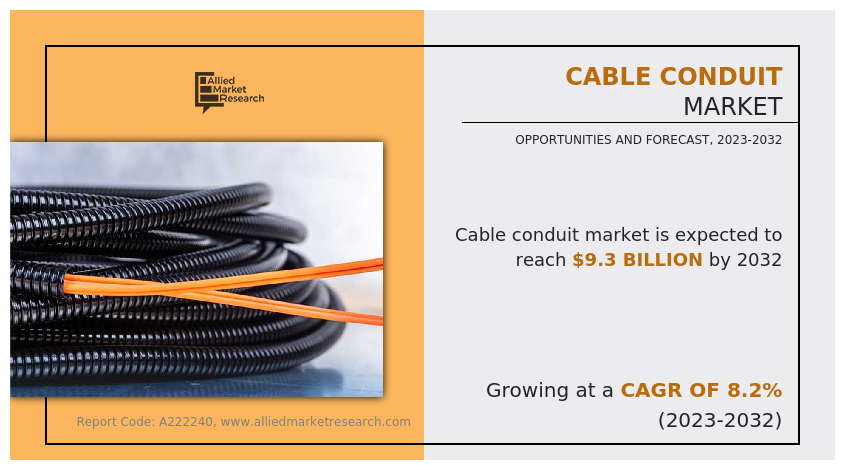
A cable conduit is a protective tube or piping system used to encase and safeguard electrical cables, wires, or communication lines. These conduits are typically made of materials such as PVC, metal, or fiberglass, offering properties such as durability and resistance to environmental factors such as moisture, UV radiation, and fire-retardant capabilities. They serve to prevent damage, tampering, and interference with the enclosed cables while also facilitating organized cable management and ease of maintenance. Cable conduits find extensive applications in construction, industrial settings, and infrastructure projects, ensuring the safe and efficient transmission of electrical or data signals.
The increasing demand for fireproofing materials in various end-use industries, coupled with a concerning increase in fire accidents, is expected to drive the demand for cable conduits.
In recent years, fire safety has become an important concern across sectors such as residential, commercial, industrial, and infrastructure development. Fire accidents not only pose substantial risks to human life but also result in extensive damage to property and critical infrastructure. To mitigate these risks, there is a growing emphasis on implementing fire-resistant materials and systems, including fireproof cable conduits. These conduits are designed to withstand high temperatures and prevent the spread of fire along electrical and data cabling systems, safeguarding both life and property.
Furthermore, regulatory bodies and building codes are increasingly mandating the use of fire-resistant materials such as fireproof cable conduits, further boosting their demand. As industries prioritize safety measures and adhere to stricter regulations, the cable conduit market growth is expected to experience a notable surge in demand due to its vital role in fire prevention and safety enhancement.
The escalating demand for secure and reliable wiring systems, coupled with significant growth in commercial construction projects, is poised to be a potent driver for the cable conduit market size.
Businesses and industries increasingly prioritize safety and data security, cable conduits play a pivotal role in safeguarding electrical and data cabling systems from external threats and environmental factors. This emphasis on protection against hazards such as fire, moisture, and physical damage has spurred the adoption of cable conduits in various applications. Simultaneously, the surge in commercial construction activities, including office complexes, retail spaces, and hospitality establishments, demands extensive electrical and communication infrastructure. Cable conduits are integral to these projects as they ensure organized and secure cable routing, meeting stringent building codes and regulations. This convergence of heightened security concerns and robust commercial construction activities positions the cable conduit market for substantial growth, reflecting the industry's critical role in enabling safe and reliable wiring systems in modern structures.
As wireless communication technologies continue to evolve and expand their capabilities, there is a growing shift away from traditional wired infrastructure, which includes cable conduits. Wireless systems offer greater flexibility, scalability, and ease of installation compared to their wired counterparts, making them an attractive option for various applications. Industries such as telecommunications, home automation, and industrial automation are increasingly opting for wireless solutions, reducing their reliance on physical cable conduit networks. This shift in preference can hamper the growth of the cable conduit market share, as it reduces the demand for these products. Thus, advancements in wireless technology are hampering the cable conduit Market scope.
Fiber optic cable conduits represent a highly promising and lucrative opportunity within the cable conduit market forecast. As the demand for high-speed internet and data transmission continues to surge, the need for robust and protective conduits for fiber optic cables grows exponentially. These conduits safeguard the delicate fiber optics from bending, environmental factors, and physical damage while ensuring optimal signal integrity. As the world becomes increasingly dependent on high-speed connectivity for communication and data transfer, companies specializing in fiber optic cable conduits are projected to capitalize on this expanding market, offering essential solutions for telecommunications, data centers, and other industries driving the digital revolution.
The cable conduit market is segmented on the basis of type, product type, end-user, and region. By type, the market is divided into rigid cable conduit and flexible cable conduit. On the basis of product type, it is categorized into metal conduit, nylon conduit, and polyamide conduit. On the basis of end-users, it is categorized into commercial construction, IT & and telecommunication, railways, energy, manufacturing, healthcare, and others. Region-wise, the market is studied across North America, Europe, Asia-Pacific, and LAMEA.
The major players operating in the global cable conduit market are Eaton Corporation plc, Hubbell.Inc., Schneider Electric, Anamet Electrical, Inc., Legrand, Shanghai Qinkai Industry Co.,Ltd., Atkore, Guangdong Ctube Industry Co., Ltd., Electri-Flex Company, Zekelman Industries, Flucon Components Pvt. Ltd., Supa Flex, Trinity Touch, AerosUSA Inc.
Other players include Allied Tube & Conduit, Intertek Group plc, Prime Conduit, Inc., Robroy Industries, Inc., ABB Ltd., Calpipe Industries, Inc.
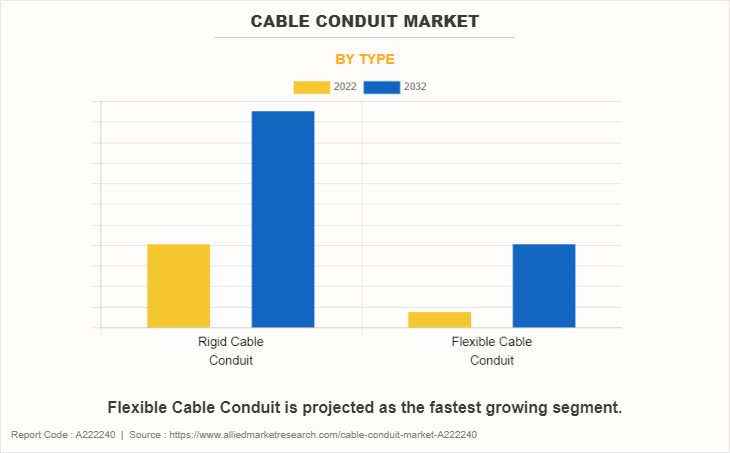
The rigid cable conduit segment accounted for more than half of the global cable conduit market revenue. This is due to an increase in infrastructure development, a rise in demand for secure and durable cable protection solutions, stringent regulations, and the growth in the adoption of automation and smart technologies in various industries. These factors are fueling the demand for rigid cable conduit systems as they provide robust protection for critical electrical and data cables.
Flexible cable conduit is expected to register the highest CAGR of 8.6%. This is due to an increase in demand for cable protection in the industrial and construction sectors, the rise of automation and IoT applications, and stringent safety regulations. In addition, innovations in materials and design are expanding the market, making it more adaptable to various industries and environments.
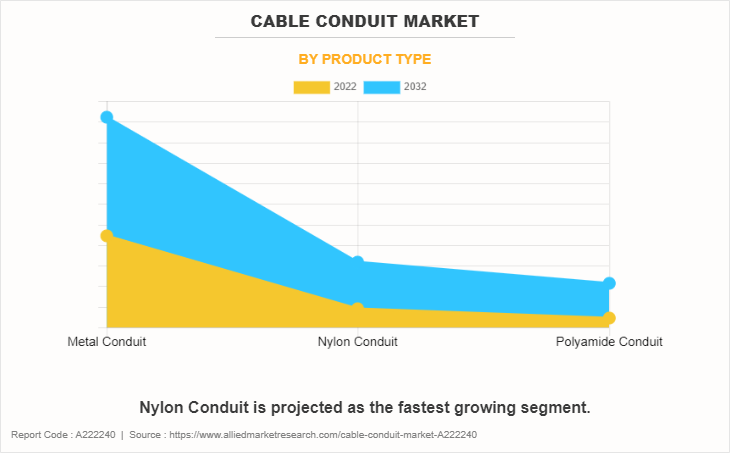
The metal conduit segment accounted for more than half of the global cable conduit market revenue. This is due to increased infrastructure development, a rise in demand for robust and durable conduit systems in industrial applications, and a shift toward sustainable and fire-resistant materials. In addition, stricter regulations for safety and the expansion of the construction and manufacturing sectors are driving the adoption of metal conduits.
Nylon conduit is expected to register the highest CAGR of 8.7%. This is due to its durability, resistance to harsh environments, ease of installation, and increase in demand in industries such as telecommunications and automotive. In addition, growth in emphasis on cable management and the expansion of infrastructure projects are driving the adoption of nylon conduits, contributing to its market growth.
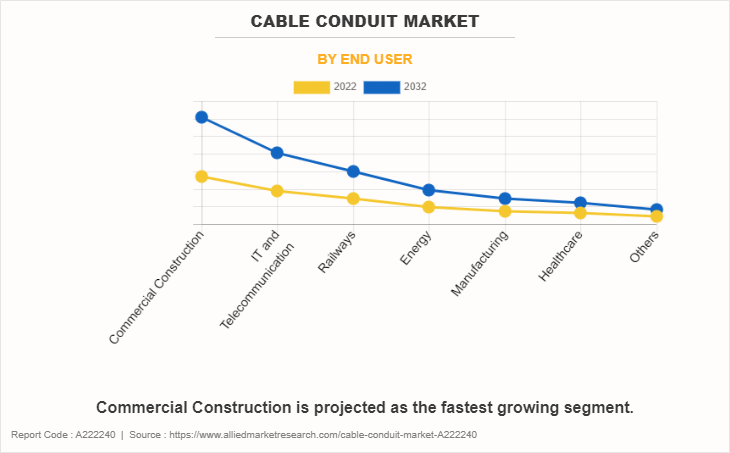
The commercial construction segment accounted for nearly one-third of the global cable conduit market revenue and is expected to register the highest CAGR of 8.8%. The increasing demand for modern office spaces and commercial complexes drives the need for advanced electrical and data infrastructure. In addition, stringent building codes and safety regulations necessitate high-quality cable management systems. The integration of smart building technologies further boosts the demand for innovative conduit solutions. Furthermore, the ongoing urbanization and expansion of commercial hubs worldwide fuel the construction of new projects, creating a robust market for cable conduits.
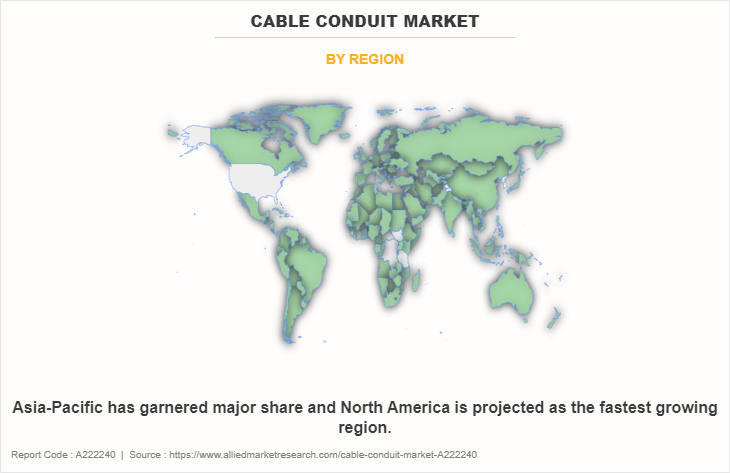
Asia-Pacific held the highest market share in terms of revenue in 2022, accounting for more than one-third of the global cable conduit market revenue. Rapid urbanization and industrialization in the region are significant growth drivers for the Asia-Pacific cable conduit market. As infrastructures in the region develop and expand, there is a rising demand for dependable electrical systems, which increases the product's market share. Population growth, urban migration, and government initiatives to promote infrastructure development are driving substantial construction activity throughout the Asia-Pacific region.
Additionally, there is a rise in e-commerce, a boom in the retail sector, and a rise in demand for commercial spaces, including shopping centers and retail outlets. These commercial structures necessitate robust electrical systems and conduit installations to support lighting, HVAC systems, security systems, and other electrical applications, which is anticipated to positively impact the Asia-Pacific cable conduit market.
Impact Of Russia Ukraine War On the Cable Conduit Market
The impact of the Russia-Ukraine war on the cable conduit market can be significant and multifaceted, as it affects the global supply chain, trade dynamics, and economic stability in various ways.
Ukraine and Russia are both significant players in the global manufacturing and supply chain ecosystem. Ukraine, in particular, has a substantial presence in the production of steel and metal products, which are essential for cable conduit manufacturing. Any disruptions in the supply of raw materials from these countries can lead to shortages and price fluctuations in the cable conduit market.
The uncertainty and instability caused by the war can lead to fluctuations in commodity prices, including metals like steel, aluminum, and copper, which are commonly used in cable conduit production. These price fluctuations can impact the cost of manufacturing cable conduits and, subsequently, their market prices.
Geopolitical tensions can disrupt international trade and diplomatic relations. Trade restrictions, sanctions, or tariffs imposed on Russia or Ukraine can affect the flow of cable conduit products across borders. Companies may face challenges in exporting and importing goods, potentially leading to delays and increased costs.
Ukraine is a transit route for natural gas pipelines that supply Europe. Any disruptions in energy supply due to the war could impact manufacturing facilities, potentially affecting the production and distribution of cable conduits, as well as raising energy costs for manufacturers.
Investors and businesses are generally averse to uncertainty and political instability. The Russia-Ukraine conflict can create an atmosphere of uncertainty that may lead to reduced investments in the cable conduit industry. Companies may delay expansion plans or investments in new technologies, impacting market growth.
The impact of the war may vary by region. Countries closer to the conflict zone may experience more immediate disruptions in trade and supply chains. On the other hand, regions that are less dependent on Russian or Ukrainian resources may be less affected.
In response to these uncertainties, cable conduit manufacturers may consider diversifying their supplier base and exploring alternative sourcing options for raw materials. This could lead to changes in the global supply chain and may affect traditional suppliers.
On the flip side, increased infrastructure spending to support military and defense efforts in the region could lead to increased demand for cable conduits and related products in those specific regions.
Key Benefits For Stakeholders
- This report provides a quantitative analysis of the market segments, current trends, estimations, and dynamics of the cable conduit market analysis from 2022 to 2032 to identify the prevailing cable conduit market opportunities.
- The market research is offered along with information related to key drivers, restraints, and opportunities.
- Porter's five forces analysis highlights the potency of buyers and suppliers to enable stakeholders make profit-oriented business decisions and strengthen their supplier-buyer network.
- In-depth analysis of the cable conduit market segmentation assists to determine the prevailing market opportunities.
- Major countries in each region are mapped according to their revenue contribution to the global market.
- Market player positioning facilitates benchmarking and provides a clear understanding of the present position of the market players.
- The report includes the analysis of the regional as well as global cable conduit market trends, key players, market segments, application areas, and market growth strategies.
Cable Conduit Market Report Highlights
| Aspects | Details |
| Market Size By 2032 | USD 9.3 billion |
| Growth Rate | CAGR of 8.2% |
| Forecast period | 2022 - 2032 |
| Report Pages | 287 |
| By Type |
|
| By Product Type |
|
| By End User |
|
| By Region |
|
| Key Market Players | Eaton Corporation plc, Schneider Electric, Electri-Flex Company, Trinity Touch, Flucon Components Pvt. Ltd., Guangdong Ctube Industry Co., Ltd., AerosUSA Inc., Shanghai Qinkai Industry Co., Ltd., Zekelman Industries, Anamet Electrical, Inc., Supa Flex, Legrand, Atkore, Hubbell Inc. |
Analyst Review
According to the insights of the CXOs of leading companies, the increasing demand for secure and organized cable management solutions in various industries, including construction, telecommunications, and manufacturing, is propelling the market expansion of cable conduit. Cable conduits protect wires and cables from damage, ensuring uninterrupted connectivity, which is critical in today's digital era. Moreover, stringent regulations and safety standards mandating the use of conduit systems further boost market growth. However, the high initial installation cost of cable conduit systems can deter smaller businesses from adopting these solutions, limiting market penetration. In addition, the complexity of retrofitting existing structures with conduit systems.
The CXOs further added that the cable conduit market presents promising opportunities. The ongoing expansion of smart cities, IoT deployment, and the rollout of 5G networks create a strong demand for robust and adaptable cable conduit systems to support the infrastructure required for these technologies. Furthermore, advancements in conduit materials and designs, such as flexible and corrosion-resistant conduits, open avenues for innovation and market expansion.
Asia-Pacific is the largest regional market for Cable Conduit.
Surge in demand for highly secure and safe wiring systems, and an increase in commercial construction activities and high demand for cable conduit due to their beneficial properties are the driving factors of the Cable Conduit Market.
Escalating demand for cable conduit for electricity/power generation is the upcoming trend of the Cable Conduit Market in the world.
The commercial construction is the leading end-user of the Cable Conduit Market.
The Cable Conduit Market is studied across North America, Europe, Asia-Pacific, and LAMEA.
Eaton Corporation plc, Hubbell.Inc., Schneider Electric, Anamet Electrical, Inc., Legrand, Shanghai Qinkai Industry Co.,Ltd., Atkore, Guangdong Ctube Industry Co., Ltd., are the top companies to hold the market share in Cable Conduit.
The global cable conduit market was valued at $4.4 billion in 2022 and is projected to reach $9.3 billion by 2032, growing at a CAGR of 8.2% from 2023 to 2032.
Loading Table Of Content...
Loading Research Methodology...



